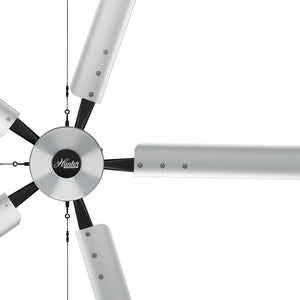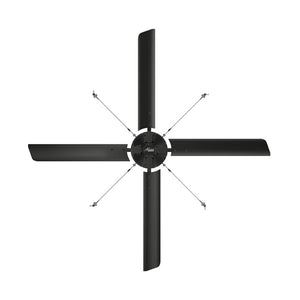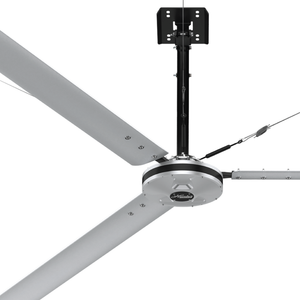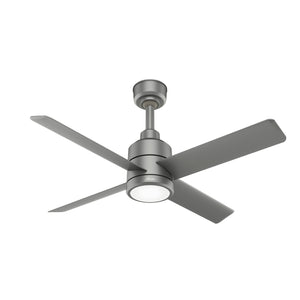Industrial Fan Blades That Rule the Airwaves
High-Volume Low-Speed (HVLS) fans are known for their ability to move large volumes of air at low speeds, making them an ideal solution for air circulation in large spaces.
But what makes HVLS industrial fans so effective at creating a comfortable and productive environment? One crucial factor is the fan blade design. In this article, we'll take a closer look at the various HVLS fan blade systems and shapes and explore how their designs affect airflow, efficiency and overall fan performance. We'll also cover factors such as blade design, angle and length.
Finally, we'll discuss how HVLS industrial fan blades impact the amount of air moved by the fan.
Industry Leading Efficiency
How HVLS Fan Blade Systems Work

HVLS fan blade systems, also known as industrial outdoor fans, are designed to move large volumes of air at low speeds. These fans typically have large fan blades with a diameter ranging from 7 to 24 feet and are used in large spaces such as:
- Warehouses
- Distribution Centers
- Manufacturing Facilities
- Barns
The HVLS fan blade system generates a large column of air that moves slowly and evenly across the space. The slow movement of the air creates a gentle breeze that circulates throughout the room, creating a more comfortable environment for workers and reducing the temperature stratification that can occur in large spaces.
To maximize their efficiency, HVLS fans are often used in conjunction with other heating, ventilation and air conditioning (HVAC) systems. By combining HVLS fans with other ventilation systems, it is possible to create a more energy-efficient solution.
HVLS Fan Blade Design

HVLS fan blade design involves several considerations, including the blade shape, angle and length.
-
Blade shape is a function of the application and can range from flat blades to curved blades, depending on the desired airflow pattern.
-
Blade angle is the angle between the blade chord and the plane of rotation and is set to optimize airflow performance.
-
Blade length is the distance from the center of rotation to the blade's tip and is designed to provide maximum airflow while maintaining structural integrity. HVLS industrial fan blades have a generous diameter to move large volumes of air at low speeds. Longer blades allow for greater air movement but require more robust support to maintain structural integrity.
While there are other types of fan blades, HVLS fans typically feature airfoil blades. Engineered to produce a smooth, uniform airflow that circulates throughout the space, airfoil blades are shaped like an airplane wing, allowing the fan to move large volumes of air at low speeds. The curved shape of the blades helps to create a smooth, even flow of air, reducing noise.
In addition to fan blade design, other factors such as blade diameter can also affect the performance of an HVLS fan blade system. Larger diameter fans move more air at lower speeds, which reduces energy consumption and noise levels.
Mechanics of HVLS Industrial Fans
In addition to the industrial fan blades, several parts come together to maximize the performance of commercial fans.
Hub Assembly
The hub assembly is the center part of the fan that holds the blades in place. It also includes a motor and other components that allow the fan to rotate.
HVLS Fan Motor
The motor is responsible for rotating the fan blades and generating the airflow. HVLS fans typically use high-efficiency motors that operate at low speeds for extended periods. These high-efficiency motors reduce energy consumption and increase the fan's overall performance.
Drive System
The drive system transfers power from the motor to the industrial fan blades. It may include a gearbox or direct drive system to reduce the speed of the motor and increase the torque applied to the blades.
Control System
The control system allows users to adjust the speed and direction of the fan. It may include various components such as switches, remote controls or digital interfaces. Commercial applications favor wall-mounted and remote controls, as well as integration with building automation systems. These controls allow users to adjust the HVLS fan blade speed and direction to meet specific needs and optimize energy efficiency.
Mounting Hardware
HVLS fans are typically mounted from the ceiling or other high structures using mounting hardware such as cables or brackets.
By selecting the right fan blade design, size, motor technology and control system, it's possible to create an efficient system with the correct ventilation rate to improve the comfort and productivity of workers in large spaces.
Frequently Asked Questions About Industrial Fan Blades
Following are answers to questions we've received about our industrial fan blades.
How Are Industrial Fan Blades Balanced?
Industrial fan blades must be carefully balanced to ensure smooth and efficient operation. Hunter Industrial fans use a computerized dynamic balancing process.
What Is CFM?
Cubic Feet per Minute (CFM) measures the volume of airflow that a fan produces within a minute. CFM is commonly used to describe how much air is being moved or exchanged. The higher the CFM rating, the greater the air volume being moved per unit of time.
How Do You Calculate Fan CFM?
You can calculate fan CFM using the following formula:
- CFM = (Fan Speed x Fan Airflow Area) / 144
Fan Speed is the speed at which the fan operates in revolutions per minute (RPM). Fan Airflow Area is the area of the space being moved by the fan, typically measured in square feet. To calculate the Fan Airflow Area, you can simply multiply the length and width of the space being moved by the fan.
It's important to note that this formula provides an approximate calculation of the CFM, as many factors can affect the actual CFM produced by a fan, such as the design of the fan blades, the shape of the fan housing and the resistance to airflow created by the space being moved by the fan.

 100% Secure Payments
100% Secure Payments










